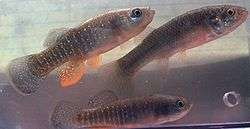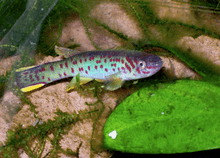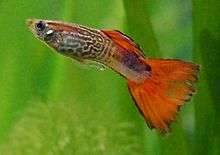Cyprinodontiformes
| Cyprinodontiformes | |
|---|---|
 | |
| Mummichog (Fundulus heteroclitus heteroclitus) Female (top right) and two males | |
| Scientific classification | |
| Kingdom: | Animalia |
| Phylum: | Chordata |
| Class: | Actinopterygii |
| Superorder: | Acanthopterygii |
| Order: | Cyprinodontiformes L. S. Berg, 1940 |
| Suborders | |
|
Aplocheiloidei | |
| Synonyms | |
|
Microcyprini Regan, 1909 | |
Cyprinodontiformes /ˌsaɪprɪnoʊˌdɒntɪˈfɔːrmiːz/ is an order of ray-finned fish, comprising mostly small, freshwater fish.[1] Many popular aquarium fish, such as killifish and live-bearers, are included. They are closely related to the Atheriniformes and are occasionally included with them. A colloquial term for the order as a whole is toothcarps, though they are not actually close relatives of the true carps – the latter belong to the superorder Ostariophysi, while the toothcarps are Acanthopterygii.
The families of Cyprinodontiformes can be divided into three groups: viviparous and ovoviviparous (all species give live birth), and oviparous (all species are egg-laying). The live-bearing groups differ in whether the young are carried to term within (ovoviviparous) or without (viviparous) an enclosing eggshell. Phylogenetically however, one of the two suborders – the Aplocheiloidei – contains oviparous species exclusively, as do two of the four superfamilies of the other suborder (the Cyprinodontoidea and Valencioidea of the Cyprinodontoidei). Vivipary and ovovivipary have evolved independently from oviparous ancestors, the latter possibly twice.
Description

Some members of this order are notable for inhabiting extreme environments, such as saline or very warm waters, water of poor quality, rain water pools devoid of minerals and made acid by decaying vegetation, or isolated situations where no other types of fish occur.
They are typically carnivores, and often live near the surface, where the oxygen-rich water compensates for environmental disadvantages. Scheel (1968) observed the gut contents were invariably ants, others have reported insects, worms and aquatic crustaceans. Aquarium specimens are invariably seen eating protozoans from the water column and the surfaces of leaves, however these are not apparent as stomach contents. North American "pupfish" eat plant material as well and some have adapted to a diet very high in algae to the point where one, the American Flag Fish is well known to eat algae especially thread algae in the aquarium, despite being in a family of fishes that do not generally consume any plant material. Although even this is a slight misnomer and killifish derive from some foods the carotenoids and other chemicals required to make these pigments which come from pollen grains from on the surface of and in the gut of insects they eat from the surface of the water, simulated in culture by the use of special color enhancing foods that contain them similar the same case with red factor canaries.
They are small to medium-sized fish, with small mouths, large eyes, a single dorsal fin, and a rounded caudal fin. The largest species is the cuatro ojos (Anableps dowi), which measures 34 cm (13 in)[2] in length, while the smallest, the least killifish (Heterandria formosa), is just 8 mm (0.31 in) long as an adult.[3]
Systematics

CYPRINODONTIFORMES
- Suborder Aplocheiloidei (all oviparous)
- Family Aplocheilidae – African, Asian and South American killifishes [4]
- Suborder Cyprinodontoidei
- Superfamily Funduloidea (oviparous)
- Family Profundulidae – Central American killifishes (oviparous)
- Family Goodeidae – splitfins (viviparous)
- Family Fundulidae – topminnows and North American killifishes (oviparous)
- Superfamily Valencioidea (oviparous)
- Family Valenciidae – Mediterranean killifishes
- Superfamily Cyprinodontoidea (oviparous)
- Family Cyprinodontidae – pupfishes
- Superfamily Poecilioidea
- Family Anablepidae – four-eyed fishes and relatives (ovoviviparous)
- Family Poeciliidae – livebearers and relatives (some oviparous, some ovoviviparous)
- Superfamily Funduloidea (oviparous)
References
| Wikimedia Commons has media related to Cyprinodontiformes. |
- ↑ Froese, Rainer, and Daniel Pauly, eds. (2007). "Cyprinodontiformes" in FishBase. August 2007 version.
- ↑ http://www.discoverlife.org/mp/20q?search=Anableps+dowi&flags=col3:&res=320
- ↑ Parenti, Lynne R. (1998). Paxton, J.R.; Eschmeyer, W.N., eds. Encyclopedia of Fishes. San Diego: Academic Press. pp. 148–151. ISBN 0-12-547665-5.
- ↑ Costa, W.J.E.M. (2016): Comparative morphology and classification of South American cynopoeciline killifishes (Cyprinodontiformes: Aplocheilidae), with notes on family-group names used for aplocheiloids. Vertebrate Zoology, 66 (2): 125-140.